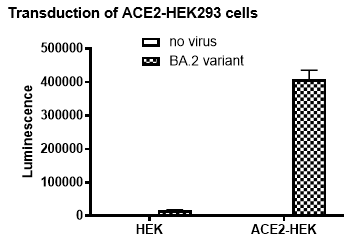78625-1 78625-2
Spike (BA.2, Omicron Variant) (SARS-CoV-2) Pseudotyped Lentivirus (Luc Reporter)
BPS Bioscience
DESCRIPTION
The pandemic coronavirus disease 2019 (COVID-19) is caused by Severe Acute Respiratory Syndrome Coronavirus 2 (SARS-CoV-2). As the first step of the viral replication, the virus attaches to the host cell surface before entering the cell. The viral Spike protein recognizes and attaches to the Angiotensin-Converting Enzyme 2 (ACE2) receptor found on the surface of type I and II pneumocytes, endothelial cells, and ciliated bronchial epithelial cells. Drugs targeting the interaction between the Spike protein of SARS-CoV-2 and ACE2 may offer protection against the viral infection. The Omicron Variant (B.1.1.529 variant) was identified in South Africa in November of 2021. This variant has a large number of mutations that allow the virus to spread more easily and quickly than other variants. As of February 2022, Omicron variants have been divided into four distinct sub-lineages: BA.1, BA.1.1, BA.2, and BA.3.
The Spike (BA.2, Omicron Variant) (SARS-CoV-2) Pseudotyped Lentiviruses were produced with SARS-CoV-2 Spike (Genbank Accession #QHD43416.1 containing all the Omicron BA.2 mutations; see below for details) as the envelope glycoprotein instead of the commonly used VSV-G. These pseudovirions contain the firefly luciferase gene driven by a CMV promoter, therefore, the spike-mediated cell entry can be measured via luciferase activity. The Spike (BA.2, Omicron Variant) (SARS-CoV-2) pseudovirus can be used to measure the activity of a neutralizing antibody against SARS-CoV-2 Omicron BA.2 variant in a Biosafety Level 2 facility.
The Spike Omicron BA.2 pseudovirus has been validated for use with target cells ACE2-HEK293 (which overexpress ACE2; BPS Bioscience #79951).
Spike Mutations in BA.2, Omicron Variant: T19I, LPPA24-27S, G142D, V213G, G339D, S371F, S373P, S375F, T376A, D405N, R408S, K417N, N440K, S477N, T478K, E484A, Q493R, Q498R, N501Y, Y505H, D614G, H655Y, N679K, P681H, N764K, D796Y, Q954H, N969K
DETAILS
- Notes: Biosafety: None of the HIV genes (gag, pol, rev) will be expressed in the transduced cells, as they are expressed from packaging plasmids lacking the packing signal and are not present in the lentivirus particle. Although the pseudotyped lentiviruses are replication-incompetent, they require the use of a Biosafety Level 2 facility. BPS Bioscience recommends following all local federal, state, and institutional regulations and using all appropriate safety precautions. Troubleshooting Guide: Visit bpsbioscience.com/lentivirus-faq for detailed troubleshooting instructions. For all further questions, please email support@bpsbioscience.com.
- Mutation: T19I, LPPA24-27S, G142D, V213G, G339D, S371F, S373P, S375F, T376A, D405N, R408S, K417N, N440K, S477N, T478K, E484A, Q493R, Q498R, N501Y, Y505H, D614G, H655Y, N679K, P681H, N764K, D796Y, Q954H, N969K
- Shiptemp: -80°C (dry ice)
- Synonyms: south africa variant, south africa lenti, pseudovirus, pseudovirion, luciferase reporter, B11529, BA2
- Warnings: Avoid repeated freeze/thaw cycles.
- Category: Coronavirus/Lentivirus
- Description: The pandemic coronavirus disease 2019 (COVID-19) is caused by Severe Acute Respiratory Syndrome Coronavirus 2 (SARS-CoV-2). As the first step of the viral replication, the virus attaches to the host cell surface before entering the cell. The viral Spike protein recognizes and attaches to the Angiotensin-Converting Enzyme 2 (ACE2) receptor found on the surface of type I and II pneumocytes, endothelial cells, and ciliated bronchial epithelial cells. Drugs targeting the interaction between the Spike protein of SARS-CoV-2 and ACE2 may offer protection against the viral infection. The Omicron Variant (B.1.1.529 variant) was identified in South Africa in November of 2021. This variant has a large number of mutations that allow the virus to spread more easily and quickly than other variants. As of February 2022, Omicron variants have been divided into four distinct sub-lineages: BA.1, BA.1.1, BA.2, and BA.3. The Spike (BA.2, Omicron Variant) (SARS-CoV-2) Pseudotyped Lentiviruses were produced with SARS-CoV-2 Spike (Genbank Accession #QHD43416.1 containing all the Omicron BA.2 mutations; see below for details) as the envelope glycoprotein instead of the commonly used VSV-G. These pseudovirions contain the firefly luciferase gene driven by a CMV promoter, therefore, the spike-mediated cell entry can be measured via luciferase activity. The Spike (BA.2, Omicron Variant) (SARS-CoV-2) pseudovirus can be used to measure the activity of a neutralizing antibody against SARS-CoV-2 Omicron BA.2 variant in a Biosafety Level 2 facility. The Spike Omicron BA.2 pseudovirus has been validated for use with target cells ACE2-HEK293 (which overexpress ACE2; BPS Bioscience #79951). Spike Mutations in BA.2, Omicron Variant: T19I, LPPA24-27S, G142D, V213G, G339D, S371F, S373P, S375F, T376A, D405N, R408S, K417N, N440K, S477N, T478K, E484A, Q493R, Q498R, N501Y, Y505H, D614G, H655Y, N679K, P681H, N764K, D796Y, Q954H, N969K
- Formulation: The lentivirus particles were produced from HEK293T cells. They are supplied in cell culture medium containing 90% DMEM + 10% FBS.
- Supplied As: The titer will vary with each lot; the exact value is provided with each shipment. Based on experiments performed by scientists at BPS Bioscience, 78625-1 (100 µl) provides sufficient signal-to-noise ratio to perform 100 reactions, and 78625-2 (500 µl x2) for 1000 reactions. The amount of virus added to the cells can even be titrated further down according to the user's need.
- Unspsc Code: 41106621
- Unspsc Name: Virus mediated expression vectors or kits
- Applications: Screen for or titrate neutralizing antibodies against SARS-CoV-2 Spike Omicron BA.2 variant in ACE2-HEK293 cells.
- Product Type: Lentivirus
- Biosafety Level: BSL-2
- Related Products: 60690, 60187, 79951, 101326
- Storage Stability: Lentiviruses are shipped with dry ice. For long term storage, it is recommended to store the virus at -80°C. Avoid repeated freeze-thaw cycles. Titers can drop significantly with each freeze-thaw cycle.
- Scientific Category: Coronavirus

